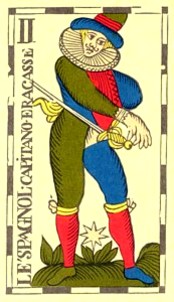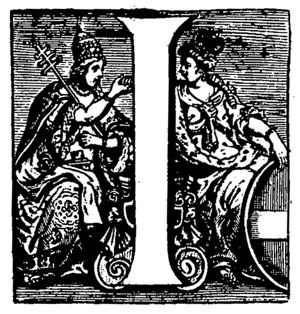II • LE'SPAGNOL • CAPITANO FRACASSE
the Spanish • Captain Fracasse
Shows the character of
Captain Fracasse, a character from the
Commedia dell'Arte.
The name of the Spanish Captain, Fracasse, means:
Fracassé: m. ée: f. Broken, crashed; extreamly crushed; wracked; battered; ruined, made hauocke of.
Randle Cotgrave
A Dictionary of the French and English Tongues (1611)
The Spanish Captain is a braggard, who masks his cowardice with his bravado. In regards to the element of deceit, it may be related to the Papesse, which it replaces, in as much as the Papesse may have been identified by some with Pope Joan. The image is thought to be based on
The Spaniard by Lasne, 1635:
The text to the engraving says:
"Un Espagnol se tient debout dans un paysage de montagnes désolées ; il a la main droite, en un geste précieux, sur la garde de son épée, dont le fourreau abîmé semble montrer qu'il ne l'utilise guère. Il porte un cure-dents sur l'oreille. Son costume sombre est beaucoup plus sobre que celui dont Bosse l'affuble."
Which I roughly translate as:
"A Spaniard stands upright in a landscape of desolate mountains; his right hand, in a precious gesture, is on the guard of his sword, the damaged sleeve of which seems to show that he hardly uses it. He carries toothpicks on his ear. His dark costume is much more sober than the puffed up ruffles with which they are worn." [Not quite sure about the meaning of "que celui dont Bosse l'affuble" and my translation there may be completely wrong - anyone who knows better please feel free to correct.]
There is also the six line poem:
De bien loin au de la des mons,
Ie viens pour vois ses rodomons.
Qui vantent par tout leur courage.
Mais croyant qu'ilz n'ont pas le cœur,
De me voir sans mourir de peur,
Ie me fais voir dans ceste jmage.
"From very far across the mountains,
I come to see their bragging.
Who boast of their courage everywhere.
While believing that they don't have the heart
To see me without dying of fear,
As I appear in this image".
(Trans. Ross Caldwell)
There is also possibly some socio-political polemics or recent historical reference ['recent' to the period in which the pattern appears] going on with the choice of this card. The connection being possibly the War of the Spanish Succession, in which the Spanish Netherlands [which incorporates the region in which the Belgian Tarot appears] becomes the Austrian Netherlands.
The War of Spanish Succession also resulted of course in the Austrian takeover of the former French dominions in Italy:
"In the opening shots of that war, Eugene defeated French armies in northern Italy. As the area of French offensive action moved north, and as the war spread to include other nations such as England, Eugene joined forces for the first time with his English counterpart, the Duke of Marlborough. Together they defeated the French in Bavaria at the Battle of Blenheim (1704). For the next three years he was engaged in fighting in northern Italy and Provence, were he suffered defeats in Cassano, but finally he defeated French armies in the decisive battle of Turin (1706), after which Louis XIV had to withdraw all French forces from Italy. Eugene attacked French Toulon on 1707, but siege was unsuccessful.
Eugene then moved north to Flanders, where he joined up with Marlborough to win the battles of Oudenarde and Malplaquet. Unfortunately, the follow-up invasion of France that would have ended the war was blunted by the marginal victory of Malplaquet, and the retirement of Britain from the war. After one more year of fighting, Austria signed a favourable peace with France, in 1714.
One of the new Austrian possessions after the War of the Spanish Succesion was the former Spanish, now Austrian Netherlands. Eugene was made governor of this area, then later became vicar of the Austrian lands in Italy."
Quote from article on Prince Eugene of Savoy in:
http://en.wikipedia.org/wiki/Prince_Eugene_of_Savoy
V • BACUS
Bacchus: the god of wine shown sitting on a cask, drinking from a flask.
Bacchus spelt 'bacus' or 'bacvs', was also a word that also meant a dicing table:
quote:
"The Ginny hen floure is called of Dodonas, Flos Meleagris: of Lobelius, Lilio-narcissus variegata, for that it hath the floure of a Frittio Lilly, and the root of Narcissus: it hath Checquered Daffodill beene called Fritillaria, of the table or boord upon which men play at Chesse, which square checkers the floure doth very much resemble; some thinking that it was named Fritillus: whereof there is no certainty; for Martial seemeth to call Fritillus, bacus, or the Tables whereon men play at Dice, in the fifth booke of his Epigrams, writing to Galla.
The sad Boy now his nuts cast by,
Is call'd to Schoole by Masters cry:
And the drunke Dicer now betray'd
By flattering Tables as he play'd,
Is from his secret tipling house drawne out,
Although the Officer he much besought,
In English we may call it Turky-hen or Ginny-hen Floure, and also Checquered Daffodill, and Fritillarie, according to the Latine." end quote from:
Thomas Johnson, The Herbal or General History of Plants(1633)
As in the TdB the replacement of the Pope by a wanton pagan god is possibly polemical satire.
According to Andy Pollet:
"The other new subject, Bacchus, was probably inspired by the illustrations found on German-suited cards; still today in some of the German regional patterns used in the south of the country, the ace or daus of Acorns is decorated with a young Bacchus riding a cask. To fill the gap left by the Pope, the Franco-Belgian tarot may have picked a popular subject from an already existing pattern."
Bacchus also appears on the 2 of Cups in the Chaffard TdM [1740's] ; in terms of the relationship to the 2 of cups there is the Labyinth by Andrea Ghisi, 1616 [see Kaplan Vol II p.305] which shows bacchus astride a barrel squeezing grape juice into 2 cups.
As political satire the connection is probably to the Spanish Succession and the independence of the low countries, to Philip V of Spain and Pope Clement XI. We have a connection between Clement XI , the Low Countries and 'bacvs' too through his banning of the bacchic revels of the Netherlanders artists society the Bentvueghels in Rome in 1720:
http://en.wikipedia.org/wiki/Bentvueghels
XIIII • LA TEMPERENCE
Temperance
Temperance holds a jug in one hand pouring liquid into a jug on the ground... She has a banner that reads Fama Sol...
"Van Mander berated artists not just for excessive drinking, but for general dissolute conduct, noting unbridled, riotous and “gek” (crazy) behavior and bemoaning how poorly it reflected upon the profession giving it a “bad reputation.”
Van Mander was also concerned about artists squandering their money on so many sensual delights. He frequently equated artistic fame with wealth, and bemoaned what he saw as artist’s potential for fame pour out of their pockets and into a wineglass."
DISSOLUTE SELF-PORTRAITS IN SEVENTEENTH-CENTURY DUTCH AND FLEMISH ART by Ingrid A. Cartwright, Ph.D., 2007 p.146
kwaw said:
...We have a connection between Clement XI and 'bacvs' too through his banning of the bacchic revels of the Netherlanders artists society the Bentvueghels in Rome in 1720:
http://en.wikipedia.org/wiki/Bentvueghels
"Their group affiliation (Schildersbent translates as “painter’s clique”) was based largely on the rites and rituals they held, including elaborate initiation ceremonies and feasts that all featured elements of Bacchic worship, but moreover, bacchanalian excess...
"... A drawing (Anonymous, Museum van Boijmans-Van Beuningen, Rotterdam) and painting (by Domenicus van Wijnen, known today in a ca. 1690 engraving by M. Pool) after a Bentveughel initiation ceremony shows a group of men surrounding a plump figure of Bacchus straddling a barrel and supplying everyone with wine."
DISSOLUTE SELF-PORTRAITS IN SEVENTEENTH-CENTURY DUTCH AND FLEMISH ART by Ingrid A. Cartwright, Ph.D., 2007 p.140
The Bentveughels celebrated drunkenness, revelry, sex and dissolution as a means to 'divine frenzy', madness as a route of inspiration. The elevation of the Fool to the highest trump in this deck could be seen as an expression of that.






